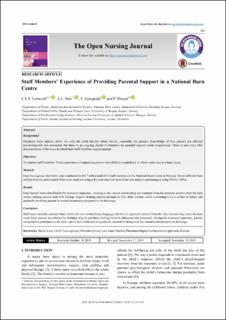| dc.contributor.author | Lernevall, Lina Sophie Toft | |
| dc.contributor.author | Moi, Asgjerd Litleré | |
| dc.contributor.author | Gjengedal, Eva | |
| dc.contributor.author | Dreyer, Pia Sander | |
| dc.coverage.spatial | Norway | en_US |
| dc.date.accessioned | 2020-08-11T10:49:55Z | |
| dc.date.available | 2020-08-11T10:49:55Z | |
| dc.date.created | 2020-03-13T17:32:44Z | |
| dc.date.issued | 2019 | |
| dc.identifier.citation | Lernevall, L. S. T., Moi, A. L., Gjengedal, E. & Dreyer, P. (2019). Staff members’ experience of providing parental support in a national burn centre. The Open Nursing Journal, 13(1), 211-219. | en_US |
| dc.identifier.issn | 1874-4346 | |
| dc.identifier.uri | https://hdl.handle.net/11250/2671467 | |
| dc.description.abstract | Background
Paediatric burn injuries affect not only the child but the whole family, especially the parents. Knowledge of how parents are affected psychologically has increased, but there is an ongoing dearth of literature on parental support while hospitalised. There is also very little documentation of the ways in which burn staff members support parents.
Objectives
To explore staff members’ lived experiences of supporting parents with children hospitalised at a burn centre due to a burn injury.
Methods
Four focus group interviews were conducted in 2017 with a total of 21 staff members at the National Burn Centre in Norway. Seven different burn staff professions participated. Data were analysed using a Ricoeur-inspired method for text analysis and managed using NVivo 12Plus.
Results
Four themes were identified in the treatment trajectory: creating a safe, secure and trusting environment from the moment parents enter the burn centre; helping parents deal with feelings of guilt; helping parents navigate in their daily routines while continuing to be a mother or father; and gradually involving parents in wound treatment as preparation for discharge.
Conclusion
Staff must carefully consider their verbal and non-verbal (body) language and how to approach parents from the very moment they enter the burn ward. Most parents are affected by feelings of guilt and these feelings must be addressed and processed. During the treatment trajectory, parents are guided to participate in the daily care of their child and are gradually assisted in taking over the wound treatment prior to discharge. | en_US |
| dc.language.iso | eng | en_US |
| dc.publisher | Bentham Open | en_US |
| dc.rights | Navngivelse 4.0 Internasjonal | * |
| dc.rights.uri | http://creativecommons.org/licenses/by/4.0/deed.no | * |
| dc.subject | burns | en_US |
| dc.subject | care | en_US |
| dc.subject | child | en_US |
| dc.subject | focus groups | en_US |
| dc.subject | multidisciplinary care team | en_US |
| dc.subject | parents | en_US |
| dc.subject | phenomenological hermeneutical approach | en_US |
| dc.subject | Ricoeur | en_US |
| dc.title | Staff members' experience of providing parental support in a national burn centre | en_US |
| dc.type | Journal article | en_US |
| dc.description.version | publishedVersion | en_US |
| dc.rights.holder | © 2019 Lernevall et al | en_US |
| dc.subject.nsi | VDP::Medisinske Fag: 700::Helsefag: 800::Sykepleievitenskap: 808 | en_US |
| dc.source.pagenumber | 211-219 | en_US |
| dc.source.volume | 13 | en_US |
| dc.source.journal | Open Nursing Journal | en_US |
| dc.source.issue | 1 | en_US |
| dc.identifier.doi | 10.2174/1874434601913010211 | |
| dc.identifier.cristin | 1801632 | |
| cristin.ispublished | true | |
| cristin.fulltext | original | |
| cristin.qualitycode | 0 | |

